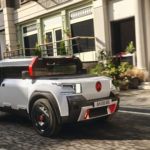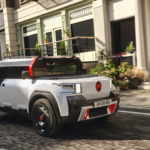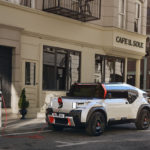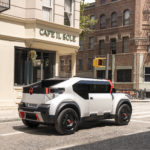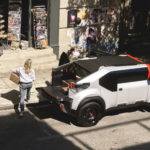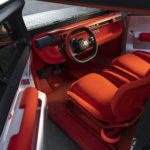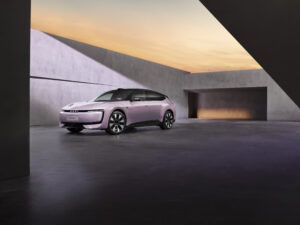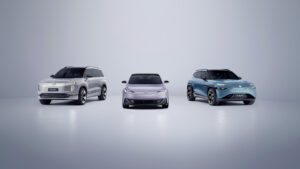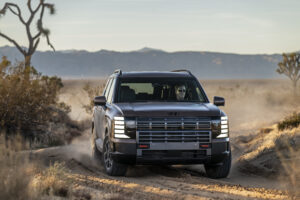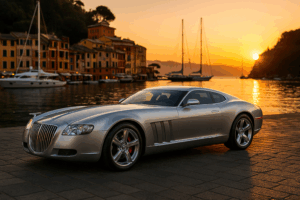CITROËN OLI [all-ë]: RADICAL, RESPONSIBLE AND OPTIMISTIC
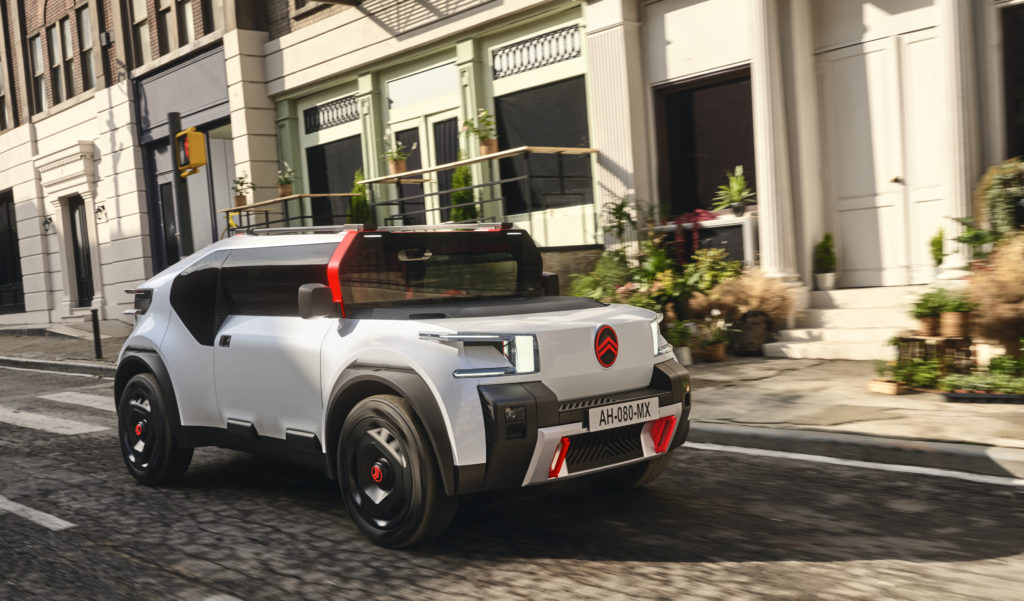
Copyright Maison Vignaux @ Continental Productions

1.IMPETUS 2.AMBITION 3.INGENUITY 4.MISSION
For Citroën, predicting the future of affordable personal mobility is an obsession, and the success
of Ami has provided the impetus to take ‘unconventional’ to a new level in the conceptual oli.
The innovative Ami demonstrated how Citroën dares to do things differently to meet its commitment of making straightforward all-electric transportation available to all. It also provided the stimulus for oli, a striking and innovative ‘laboratory on wheels’ designed to move the needle for family mobility by bucking industry trends for heavier, more complex and expensive electric cars.
“We called this project ‘oli’ as a nod to Ami, and because it sums up what the vehicle is all about – further proof that only Citroën can deliver no-nonsense, ALL-Electric mobility to ALL kinds of people in unexpected, responsible and rewarding ways,” says Citroën CEO, Vincent Cobée.
It is Citroën’s guiding light: an adventurous, multi-faceted manifesto of clever and achievable ideas focused on reducing weight and complexity to maximise efficiency, versatility and accessibility. oli is a destination, in which the trend for ‘more’ is exchanged for the constructive ‘enough’: “as much as you need or is necessary”. [Collins English Dictionary]
Significantly, customers can expect to see many of the concepts and innovations showased in oli flowing through to Citroën’s future electric family vehicles.
While Ami was literally a small step in ‘walking the talk’, oli signals an exciting leap forward. Rather than being a 2500kg ‘palace on wheels’ filled with screens and gadgets, oli proves that with enough of the things customers need and want, supported by the inventive use of responsible materials and a sustainable production process, the societal need can be met for inexpensive yet desirable zero-emission mobility that enables multiple lifestyles.
Vincent Cobée explains why the time is right for oli: “Three societal conflicts are happening simultaneously – first is the value of and dependence on mobility, second is economic constraints and resource uncertainty, and third is our growing sense of desire for a responsible and optimistic future. Consumers can sense the era of abundance may be over and increasing regulations as well as rising costs may limit our ability to move around freely. At the same time, a growing awareness of the need to accelerate efforts to prevent climate change is making us more eco-conscious and discerning.”
A typical mid-70s family car weighed around 800kg and was 3.7 m long and 1.6m wide. Today’s equivalents have grown to more than 1200kg, at least 4.3 m long and 1.8m wide. Some even weigh more than 2500kg. Legal and safety requirements have driven some of this, but if the trend continues and we carry on parking these vehicles 95% of each day and driving 80% of journeys with a single occupant, the conflict between the need to protect our planet and the future promise of sustainable, electrified mobility will not easily be resolved.
“Citroën believes electrification should not mean extortion and being eco-conscious should not be punitive by restricting our mobility or making vehicles less rewarding to live with. We need to reverse the trends by making them lighter and less expensive and find inventive ways to maximise usage and refurbish for subsequent owners. Otherwise, families won’t be able to afford the freedom of mobility when all-electric vehicles become the only option available to them. oli is a powerful demonstration of how Citroën is confronting these conflicts head-on and with optimism.
1.IMPETUS 2.AMBITION 3.INGENUITY4.MISSION
For Laurence Hansen, head of Citroën Product Development and Laurent Barria, head of Citroën Marketing and Communication, oli epitomises Citroën’s mission to democratise electric mobility in an agreeable way.
Citroën believes the time is right to say ‘enough’ to the trend for excess and expense and to focus instead on creating pure, honest vehicles that are lighter, less complicated and truly affordable, as well as inventive and joyful.
The quirky and uncomplicated Ami was a significant move in that direction, while electrified and all-electric models like the ë-C4 and new ë-C4-X, and light commercial vehicles like ë-Berlingo and ë-SpaceTourer, already provide access to the benefits of electrified motoring with the comfort, personality and value customers expect from Citroën.
With oli, Citroën is courageously showing how it will raise the stakes for future family mobility by re-thinking every detail to reduce resources and materials in order to make pleasing vehicles that are easier to use, understand and afford, with appropriate driving range and enhanced versatility.
“oli is a working platform to explore ingenious ideas that are realistic for future production,” says Laurence Hansen. “They won’t all come together, nor in the physical shape you see here, but the high level of innovation being showcased is inspiring future Citroëns.
TARGET: BEST LIFE CYCLE ASSESSMENT
The cleverly conceived oli is a conceptual multi-activity family vehicle with sustainability at its heart, and explicitly demonstrates how ‘best-in-class’ Life-Cycle-Assessment (LCA) can be achieved, from conception with restrained, optimal use of lightweight and recycled materials, to sustainable production processes, and from durability for an extended “life in service” to responsible end-of-life recyclability.
“We wanted to use only the amount of materials we really needed, so we have ruthlessly pursued the objective of putting the right resources where they are required, and limiting the impact of the use of those resources” says Hansen.
When the number of parts and components is intelligently reduced, the lightest and most responsible materials are used, and complexity is minimised while versatility and functionality is increased, the result is something much more efficient, very affordable and less complicated while also being unexpectedly genial in its design and usefulness.
Thoughtful details are found throughout. The seats, for example, are simply constructed and use 80% less parts than a traditional seat. They are made of recycled materials and clever ‘mesh’ backrest designs enhance the natural light inside the vehicle. They can also be easily upgraded or personalised to suit the taste of individual owners. It is a win-win as vehicle weight is reduced, they are responsible and sustainable, and the enhanced cabin ambience positively impacts occupant comfort.
“Ultimately, it’s a lifestyle choice more than a vehicle choice. You can choose to pay for all of the latest features and artificial intelligence which you only use 2% of the time when driving, or you can ask yourself “what is the responsible thing to do and how much of this do I really need?” says Hansen. “oli is a way to say enough! I do want something innovative, but I want it straightforward, affordable, responsible and long lasting. oli is all of that, and a huge amount of pleasure in your life too!”
LIGHTER, FURTHER, LONGER
Citroën oli shows that by tackling the enemies of battery-electric-vehicle range and efficiency, electric vehicles can go further, last longer, be more versatile and cost less to own.
“It’s a vicious circle – delivering more electric driving range requires a bigger battery. Adding more technology requires more power, which also means a bigger battery. All of this adds weight, complexity and cost, and the more a vehicle weighs, the less efficient it becomes,” adds Laurence Hansen. “oli shows what can happen when we take a completely different approach.”
While it appears substantial, oli is neither heavy nor cumbersome – its target vehicle weight of around 1000kg making it significantly lighter than most comparable compact SUVs.
As a result, its all-electric powertrain needs only a 40kWh battery to deliver a target range of up to 400km. By limiting top speed to 110km/h to maximise efficiency, excellent consumption of 10kWh/100km is realistic, and recharging from 20% to 80% takes just 23 minutes.
LASTING PARTNERSHIP
Citroën oli has been designed to maximise longevity and durability so, like a home, it can have multiple proprietors and a longer active life cycle. Combined with its ambitious LCA target is the goal of making it easy to repair, refurbish, upgrade and personalise so it can easily be passed on ‘as new’ to several successive owners, or kept in a family for younger generations to enjoy.
More than that, oli has prompted Citroën to re-evaluate every service and experience it provides to electric vehicle owners throughout their partnership with the brand, particularly in the face of rising costs and the challenges of mobility.
”We understand how heavy, oversized vehicles can be more of a burden than a pleasure economically and ecologically, and we know consumers are increasingly sensitive to pollution and congestion and want to be responsible when choosing brands,” says Barria. “That’s why, at Citroën, as well as focusing on making dependable vehicles, we are focused on creating lasting partnerships with customers through innovative ownership services and experiences that enable the lifestyle they want to enjoy”.
Key to this is extending the sense of wellbeing Citroën customers already get from being inside their Citroën to include everything supporting the vehicle and their entire ownership journey.
1.IMPETUS 2.AMBITION3.INGENUITY 4.MISSION
For Citroën’s development and design teams, ingenuity was the watchword in ensuring oli
is more than a “car”.
USEFUL LIFE PARTNER
Citroën oli is effectively a life partner – a useful everyday entity that helps people live life to the full, even when it’s not on the move. It is a sanctuary free from the onslaught of new technology, a member of the family to enjoy, and a device to visibly re-connect with nature and ecology.
“Rather than the home they live in or vehicle they drive, people increasingly see their ecological footprint as an authentic and positive expression of who they are and the way they live,” says Anne Laliron, head of Citroën Advanced Products and Mobility Solutions. “We believe oli will genuinely inspire them with its genial and vivacious ways of doing things differently to simplify and enjoy life while reducing our impact on the planet’s resources.”
Citroën enjoys a legacy of inventing consumer lifestyles that went with its vehicles, and as a new generation of customers is being even more creative in living with the unorthodox Ami, the optimistic spirit of oli can potentially do the same.
ELECTRIC LIFESTYLE ENABLER
A prime example of this is how oli can enable an electric lifestyle beyond its capability as a form
of zero-emission mobility.
As a useful ‘electric device’, it would seamlessly and naturally fit into the electric eco system as a key link between a home’s solar panels (which can intermittently produce excess power that can be returned to the grid), a consumer’s need for electricity on the move or at home (for example in the event of a power cut), and the wider electric network.
By supporting smart ‘Vehicle to Grid’ (V2G) capability, the potential exists for a vehicle like oli to make money for its owner by storing excess energy from home solar panels, and selling this back to energy suppliers, as well as helping to manage power issues when there is peak demand or a power outage in the grid.
Citroën oli also shows how a vehicle can perform as a home away from home for summer trips to the beach or a camping weekend in the hills, thanks to its ‘Vehicle to Load’ (V2L) capability. Considering its 40kWh battery and a power socket output of 3.6kW (the equivalent of a 230v 16amp domestic socket), oli can theoretically provide power to a 3000 w electric device for around 12 hours.
“This is brilliant if you have been swimming or got soaking wet in the rain and need to dry your hair,” says Anne Laliron. “There’s power for your hairdryer, and you can enjoy a cool or hot drink because you can plug in a mini refrigerator or coffee machine, then as night falls, you can plug in your grill and lights to dine so oli is definitely your day-to-day lifestyle partner.”
Whatever use can be imagined for oli on lifestyle trips or at the family home, it exudes clever functionality that is practical and easy to use.
DESIGN AESTHETICS DRIVEN BY FUNCTIONALITY
Striking and clearly making a statement, oli’s unconventional stance and silhouette exude personality, productivity and positivity in a footprint similar to a compact SUV at 4.20m long, 1.65m high and 1.90m wide.
It defies traditional labelling. oli can be whatever it needs to be – family limo, urban explorer, adventure vehicle, workmate, even an extension to the family home thanks to its ability to power everyday appliances, help in the event of a power cut or provide a platform for cleaning windows.
Citroën ’s head of Design, Pierre Leclercq, believes oli embraces purity and geniality for families who don’t care for automotive status and stereotypes: “There’s a purity that Citroën has always been about that other brands don’t have, and it is much more challenging to design an object that is pure but unique than it is to create something overcomplicated and make it unique. Think of iconic vehicles like the new Ami or 2CV – silhouettes that are instantly recognisable as Citroën and which, because of their pragmatism, may live longer as well.”
In oli, the aesthetic approach has been deliberately exaggerated to reinforce functionality and versatility. And, like Ami, it is not afraid to show its simple and intuitive approach and distinguishes itself with its playful use of colour highlights, bright trim materials and vivacious patterns that advocate opportunities for personalization.
“We’re not afraid to show you how the vehicle is put together, so you can see frames, screws and hinges for example. Embracing purity allows us to design differently and challenge everything. It’s like taking an analogue approach to many things that have become digital today,” adds Leclercq. “That is why we have taken a less automotive approach with oli, and it is this purity and ingenuity which will inspire elements of our design language in the coming years.”
Before designing vehicles, Leclercq studied industrial design which explains his direction: “In industrial design they teach you “don’t tell me it’s beautiful, it has to be functional”, so when we set out to do oli we made sure that form definitely followed function, as you would expect with everything from domestic appliances to utility vehicles. The way a vehicle exterior evolves is based on interior architecture – that’s super important as you can’t just do sexy on the outside without understanding the experience you want people to have inside.”
The team thought through each element of oli based on the need for multiple functionality, weight and complexity reduction by using less or common parts, and the responsible use of recycled or recyclable materials wherever possible.
Pierre Sabas, head of Citroën Advanced Design and Concept Vehicles says: “We set ambitious targets and it became an exercise in “design by process” – instead of imagining a shape and trying to find a way to do it, we started with the functionality we wanted, then we simplified everything and found clever, responsible materials as we went along to reduce weight and cost, and then we did that all over again.”
VERSATILE PLATFORM
While the bonnet, boot and roof on a traditional car look like excellent platforms to help with home chores like pruning trees, in reality there are few vehicles built with this strength and capability in mind. This is not the case with oli.
Its flat bonnet, roof and rear ‘pick-up bed’ panels which, as well as driving the vehicle’s unique silhouette, were chosen to meet the objectives for low weight, high strength and maximum durability.
Made from recycled corrugated cardboard formed into a honeycomb sandwich structure between fiberglass reinforcing panels, they have been co-created with partner BASF. They are coated in Elastoflex® Polyurethane resin covered in a protective layer of tough, textured Elastocoat®, which is often used on parking decks or loading ramps, and painted with innovative, waterborne BASF R-M Agilis® paint.
The panels are very rigid, light and strong – so strong that an adult can stand on them – and weight is reduced by 50 percent when compared to an equivalent steel roof construction. Their versatility and durability open up a world of possibilities for owners to enjoy work and recreation.
Whatever use can be imagined, from using the roof as a ladder to a platform to mount a tent, usefulness comes without added weight or cost of exotic materials. It is hard to believe that 6 kg panels can carry the weight of an adult, as well as be good looking and long lasting, but they are.
Load carrying versatility is not compromised either, as roof rails each side of the roof panel allow owners to attach accessories like bicycle racks and roofboxes for family vacations, while below the bonnet panel are neatly detailed storage areas in including compartments for charging cables plus personal and emergency items.
HORIZONTAL MEETS VERTICAL
Making a conscious decision to create flat surfaces because of the resource and materials targets allowed the team to experiment with the contrast of vertical and horizontal design elements, for example in the glass and lighting details.
“All of the key design elements on oli are perfectly horizontal or vertical, which is something we want to explore,” says Leclercq. “The usual approach would be to go for dynamic lines and other vehicle makers wouldn’t dare to do what we have done – but we are looking for honesty and efficiency in the form language.”
The windscreen is vertical because it’s the shortest distance between top and bottom and uses the smallest amount of glass. As well as reducing weight and complexity, the smaller screen is less expensive to produce or replace and lessens the exposure of occupants to the effects of the sun. It is also estimated to help reduce the power demand oli’s modest air conditioning system would make on its batteries by up to 17%.
“You could argue a vertical screen is less aerodynamic, but we don’t expect people to drive this kind of vehicle at 200 km/h. We see it being most useful in urban and suburban areas where people reduce speed and are aware of the environmental and safety aspects of everyday mobility. That is why we have limited oli’s top speed to a maximum of 110km/h.” explains Sabas.
That said, to aid efficiency, oli features an experimental “Aero Duct” system between the front section of the bonnet and the flat top panel which blows air towards the screen, creating a curtain effect to smooth air flow over the roof.
The eye-catching windscreen frame is finished with a bright ‘infra-red’ wrap – a new signature colour Citroën will use in conjunction with a new brand identity.
The contrast between horizontal and vertical is evident in the rationally thought-through side panels and glass.
The front doors follow the example set by Ami and are identical on each side, though mounted differently. They are lighter, yet still strong, and much easier to make and assemble.
Reducing complexity and simplifying construction saves 20% in weight per door compared to a typical family hatchback. Half the number of components is required, and around 7kg per door is saved by the removal of the loudspeaker, soundproofing material and electrical wiring.
The external door panel is simpler to stamp and is designed maximise interior storage. Gentle curvatures flow up the sides of the vehicle, and into the top of the side glass as it tumbles home to the roof.
Large, horizontal windows are tilted slightly towards the ground to help to reduce the effects of the sun, and manual, easy-to-operate “flip up” pantograph opening sections, similar to those used on Ami, provide fresh air ventilation.
The narrower rear doors are hinged at the rear of the vehicle and use vertical glass to give rear passengers more light and visibility. The change in form between the front and rear doors also gave an opportunity to add a passive air intake providing ventilation for rear seat passengers.
Access to the spacious cabin is wide, uncluttered and unhindered with both side doors open – ideal for when the driver needs to get straggling family members loaded efficiently.
Front and rear lighting modules are, again, uncomplicated but highly distinctive, and also play with the contrast between two horizontal lines and one vertical section. This approach will be evolved further as a distinctive Citroën lighting signature in future production vehicles
PICK-UP PARTY TRICK
Instead of the usual trunk or hatchback, oli features an unexpected, inspired exercise in useful product design.
“When you think about practicality and versatility, particularly in a compact vehicle designed to be ultra-responsible and efficient, you need to think differently. Many people find their small SUV is no more practical than a compact hatchback, so oli’s unusual pick-up bed with trunk below is our thought provoking take on how to get the best of several worlds,” says Leclercq.
Citroën oli is designed to be an easy-to-use lifestyle enabler. So whether visiting a furniture store to bring home flat packed furniture, or loading paddleboards and pop-up roof tent for a weekend at the coast, all can be accommodated in the spacious pick-up bed and trunk, thanks to its quickly and easily demonstrated party trick.
The independent rear seat headrests pop up into the roof, the rear screen glass opens upwards, and voilà – the flat 994mm wide removable load bed expands in length from 679mm to 1050mm instantly.
Versatility abounds and loading is easy. The tailgate folds down and with the load bed panel removed, there is up to 582 mm height between the vehicle floor and the rear glass. With the panel in place, 330 mm height of useful and secure trunk space is available below. The removable bed panel is light and flat, and made from the same recycled cardboard structure as the bonnet and roof panels.
Thoughtful rails each side of the bed allow users to attach hooks or accessories, and additional storage boxes are located on the sidewalls to provide secure undercover stowage.
The cleanly designed tailgate is made in two sections – a lower steel panel which contains a central licence plate recess, topped by a mesh section in black which cleverly carries an important new message visible to anyone following behind, as well as to the driver in the rear-view mirror: “Nothing Moves Us Like Citroën”.
NEW BUT FAMILIAR LOGO
As well as the subtle promise being made to customers through the tailgate, oli draws on Citroën’s rational engineering legacy to introduce a proud new Citroën identity.
While oli’s form language contrasts horizontal with vertical and rounded with flat to suggest functionality, technical competence and clever industrial design, the new ‘floating’ logo does exactly the same. Prominent chevrons are positioned boldly and horizontally across the badge to signal engineering and technical efficiency, and are contrasted with the warm softness of a vertical oval surrounding them to suggest the brand’s unwavering commitment to the wellbeing of its customers.
The new badge purposefully evokes the company’s original 1919 logo and subtly re-imagines it for future Citroëns. The identity is set to appear progressively on future product reveals, as well as throughout the Citroën corporate and dealership networks.
WHEELS KEEP ON TURNING
A key area for innovation to maximise the use of sustainable materials, enhance durability and lower expense is one owners will recognise as being potentially costly and environmentally damaging – wheels and tyres.
“Citroën’s commitment to ‘Advanced Comfort’ is well known, and wheels and tyres play a major role in occupant wellbeing,” says Sabas. “With the pressure to reduce the environmental impact of tyres, and the increasing cost of replacing or repairing damaged wheels, we decided to explore more sustainable and durable options for both, while maintaining the quality of ride comfort we expect to deliver in a Citroën.”
The ingenious and efficient 20-inch wheel and tyre combination fitted to oli marries a new hybrid wheel prototype design with a conceptual, sustainable and intelligent tyre co-created with Goodyear.
Because full aluminium wheels are expensive and energy intensive to produce and full steel wheels are heavy, the decision was taken to blend the two. The resulting hybrid wheels are 15 per cent lighter than the equivalent full steel wheel, contributing an overall vehicle weight reduction of 6kg. There are also design benefits to consider.
“Steel wheels aren’t traditionally beautiful or aerodynamic unless you cover them with a full wheel cover. On our prototype, the wheel is made of an aluminum rim bolted to a steel central hub, designed in a robust and modern way. This allows an overall weight and cost reduction. A peripherical wheel cover is added to improve the airflow around the wheel and to give a more precise and graphical look.” adds Sabas.
Citroën partnered with Goodyear to use the Eagle GO concept tyre, which combines sustainability with longevity and intelligent technology for monitoring the tyre’s condition and health.
The tyre tread compound is made of nearly all sustainable or recycled materials, including sunflower oils and rice husk ash silica, as well as pine tree resins and full natural rubber which replace synthetic, petroleum-based materials.
Great news for vehicle owners is that Goodyear has set an impressive objective for the Eagle GO concept tyre to achieve up to 500,000km lifespan through reuse of the sustainable carcass and because the 11 mm tread depth can be renewed twice across the lifetime of the tyre. The tyre is also equipped with Goodyear SightLine technology, which includes a sensor that monitors a variety of tire health parameters constantly throughout its life.
“This is the third time we have partnered with Goodyear and combining our new hybrid wheel with the innovative Eagle GO concept tyre raises the bar for sustainable, clever and low maintenance solutions, while ensuring we continue to prioritise comfort and wellbeing,” says Leclercq.
PROTECTION ALL-ROUND
Citroën oli is both protective and protected, thanks to tough exterior plastic sections which demonstrate the same purity when it comes to reducing the number of parts, using responsible materials and reducing weight.
To execute Citroën’s signature design element, partner Plastic Omnium helped create a ‘mono material’ approach to facilitate easy recycling with strong but light side protection and 100% recyclable bumpers containing 50% recycled materials. Each wheel arch is capped with an identical, strong recycled plastic protector with a horizontal top, echoing the contrast theme used for the windows and lighting modules.
Central bumper sections, like those used in Ami, are identical front and rear. Below, triangular infra-red ‘handles’ are, in fact, strong hooks which would help drivers tow another vehicle out of the mud, or pull a large stone out of the way.
Even oli’s tough white BASF R-M Agilis® waterborne paint is eco-effective with the lowest level of volatile organic compounds (below 250g/l).
INNER SPACE: THE CHALLENGING FRONTIER
Vehicle designers always reach for the stars when it comes to interior package, but so often surrender to the desire to add bigger screens, taller armrests, swooping panels, plusher seats and so on. This adds materials, weight, and cost.
“We decided to create as much space and light as we could inside oli with as little infrastructure as possible, and to maximise the use of sustainable materials,” says Leclercq. “It’s not as easy as you think because you need to make a cabin comfortable, safe and strong, and there are certain pieces of technology customers expect. We took inspiration from other forms of space efficient product design, where minimal is better – like a smart phone or hi-fi system. After all, how many buttons, dials, and screens do you really need?”
Beam Up Front:
Instead of a full dashboard with multiple screens and hidden computers, oli features a single symmetrical beam running across the width of the vehicle from which hangs the steering column and wheel on one side, a smart phone dock, and five clearly identified toggle switches for the air conditioning system in the centre.
Notably, oli uses just 34 parts in this space while a comparable compact family hatchback uses around 75 parts in its dashboard and centre console.
The beam houses an electrified rail into which accessories can be plugged via USB sockets that slide along it. This is ideal for powering devices or even plugging in your coffee maker while waiting for the kids to come out of school.
Two direct air vents, one each in front of the driver and passenger, allow the use of a smaller air conditioning unit to further aid efficiency and reduce weight.
Sitting behind and below the beam is the “sofa” made of BASF Elastollan® – a bright orange, recyclable 3D-printed Thermoplastic PolyUrethane (TPU) storage shelf featuring flexible “mushrooms” which keep objects like coffee cups or soda cans in place.
Plug And Play:
In oli, all the infotainment and communication you need is brought into the vehicle on your personal smartphone, which is docked in the central socket on the beam.
Once plugged in, phone information and apps are merged with essential vehicle data like speed and charge level This is made visible via a ‘Smartband’ system, which projects information across the width of the lower windscreen surround.
“Because your smartphone has more computing power than many vehicles, we decided to adopt a different approach to infotainment,” adds Sabas. “We all carry our phones and use apps for navigation and entertainment already, so we saw a chance to save the expense, duplication and weight of integrated systems. Just bring your own device and plug in.”
The same approach is used for in-vehicle audio. Each end of the beam is hollow and cylindrical Bluetooth loudspeakers can be ‘docked’ to provide high-quality sound for listening to podcasts or classic Sci-fi TV themes on the move. In fact, 250g of weight has been saved by eliminating the usual audio system alone.
Because the speakers are removable, sounds can be enjoyed when parked anywhere and everywhere. Hanging them on hooks on the rails in the pick-up bed outside the vehicle means you can show off your latest playlist with excellent sound quality while enjoying al fresco dining or partying on the beach.
HMI Control:
Having looked at several solutions for operating the HMI, the team came up with the unusual idea of using a joystick from a professional modular gamepad, mounted on oli’s neat steering wheel.
“The gamepad joystick works really well – it’s easy to control and is a great example of how we can transfer solutions from familiar non-automotive applications to make them work in the context of a vehicle,” says Sabas.
The steering column incorporates a rotating shift lever coupled with the vehicle’s “start stop” button, while smaller stalks operate the vehicle’s lights and indicators.
Space-Efficient:
Instead of bulky automotive armchairs to block out the light and fill the cabin, oli’s space-efficient front seats use 80% less parts than the seats in an equivalent SUV – just 8 rather than 37.
Bright orange front seats are made up of strong tubular frames onto which are mounted a comfortable base cushion covered in textile made from 100% recycled polyester which is 100% recyclable.
Innovative 3D-printed mesh backrests feature an integrated headrest and are inspired by modern office furniture. They are slim but highly supportive, comfortable and rigid exactly where they need to be.
Co-created with BASF, they are made from lightweight, 100% recyclable Thermoplastic PolyUrethane (TPU) and the material has been covered with an orange coating to ensure theylook and feel inviting. The mesh backrests amplify the feeling of space and light inside the vehicle – key contributors to occupant comfort and wellbeing.
Rear seat passengers can use the backrest’s exposed tubular frame to mount accessories – for example a small tablet device powered via a USB socket, hooks for hanging a tote bag, a cupholder frame, a magazine net like in an airliner, or a small tray for the kids to enjoy a snack on the move.
In keeping with Citroën’s commitment to comfort, front seats attach to the floor through flexible, recyclable TPU isolation rings that absorb road imperfections and vibration and echo the brand’s acclaimed “Progressive Hydraulic Cushions”.
“The construction of the front seats is completely understandable,” explains Sabas. “They are easy to dismantle, remove and recycle when you want to change the colour for example. Nothing is covered up, and there are no hidden structures – they are as straightforward as they look and a perfect example of how functionality and purity drove every element of the design.”
Equally comfortable individual rear seats are made from similar materials and the backrests fold flat to extend the rear load bay floor. Roof mounted circular TPU headrests float above each backrest and fold up into the roof when required.
On each side of the vehicle below the rear seats, and accessible when rear doors are open, is a discreet storage compartment for a first aid kit.
A storage console sits neatly in the space between the individual rear seats. Like the ‘sofa’, this orange, recyclable soft 3D-printed TPU component features flexible “mushrooms” to hold items in place. Notably, all interior BASF TPU parts can be recycled together, which is a further step towards sustainable mono-materiality as an element of the Life Cycle Assessment.
Instead of heavy inner door panels containing switches, armrests, speakers and window motors, oli’s simplified panels maximise storage while providing the infrastructure for comfort and easy opening and closing.
A large, open storage net is inserted between the inner and outer panels of the front doors, and an orange armrest pad covered in 100% recycled and recyclable polyester textile is affixed directly to a horizontal line on the panel. Opening the front doors is easy, thanks to a recyclable pull toggle presented through the panel, and directly connected to the mechanism. Screws and fixings used in the doors and seats are interchangeable which further reduces complexity.
Performance Under Foot:
Instead of hard-to-clean carpets, oli features a single-piece, modular floor covering made in partnership with BASF from Expanded Thermoplastic PolyUrethane (E-TPU). The foam is as elastic as rubber but lighter, extremely resilient and highly resistant to abrasion. It can be replaced altogether if an owner prefers a new colour.
“This high grade, high performance material is usually found in the world of sport,” boasts Pierre Leclercq. “It is used in running tracks, bicycle saddles and even in the soles of well-known running shoes because of its spring and cushioning properties which can ‘boost’ performance and comfort on the track.”
The floor is also covered with a highly elastic and waterproof coating and can be easily hosed clean. Recyclable TPU “drain plugs” in the floor make it stress-free to remove sand and seaweed or mud and mulch after a hot day at the beach or a wet day trekking through the forest.
CIRCLE OF LIFE
A key element of the oli story is how it has been conceived with longevity to create its own circular economy. It shows how a vehicle can be easily and affordably reinvented for several subsequent lives with new owners using refurbished parts, new décors or colours, and even upgraded parts over time.
Overall cost of ownership will be low, but if there is a need to replace a door, headlamp or bumper, recycled parts could be sourced responsibly via Citroën from other oli vehicles that are no longer serviceable.
Logically, if it costs more to refurbish a vehicle than to buy a new one, vehicles won’t be refurbished. oli changes this – it be more environmentally and economically positive to refurbish than replace over several lifecycles. When no longer economical to refurbish, Citroën would turn each oli into a recycled parts donor for others requiring parts or send other parts for general recycling.
1.IMPETUS 2.AMBITION 3.INGENUITY4.MISSION
With oli, Citroën is on a mission to convey serious messages about the future of affordable, sustainable and enjoyable family mobility along with the future of the brand itself:
“We took a risk with Ami, and we are taking a risk with oli because we need to push creativity for production,” saysPierre Leclercq. “There’s no sense in proposing cool materials or designs that will never influence future production vehicles. That’s why the inclusion of the new logo on oli is significant, because just as you will see elements of its design and technology in future models, the new interpretation of the Citroën badge will be our welcoming new standard”
“We have a broad customer base because we offer personal mobility from AMI to the C5-X, and not everyone may be ready to accept that you don’t need certain things,” says Laurence Hansen. “So while we’re not going to change everything overnight, Citroën wants to engage in a discussion, to ask what constitutes enough, and to demonstrate how we can do the right thing and deliver on our mission to bring responsible, affordable and joyful mobility to everyone.”
GUIDING LIGHT
Vincent Cobée recognises that a happy future depends on reforming rather than adjusting the way we spend, choose, consume, move, pollute, discard and think:
“The automotive industry is not immune from the revolutions challenging every other industry as we face up to the issues created by our abundance of consumption, and Citroën is walking the talk to prove there are unconventional ways of changing that aren’t boring or punitive. Ami is a great example of that, and we’re proud of its success as a non-conformist mobility reality for today.
With its clever thinking and messages of purity and doing the right thing, Citroën oli – our ‘lab on wheels’- shows how we can inspire future families. oli is striking and unconventional – but we’re Citroën, and we understand you don’t get noticed for making a bland statement.
Citroën oli exemplifies our mobility mission: responsible, straightforward and affordable for your daily life while still aspirational, desirable and enjoyable. It is our guiding light for the solution you’ll want to have as the only vehicle your family needs ten years from now.”

